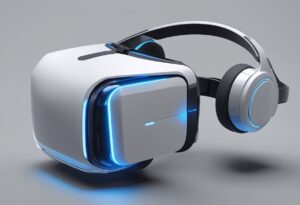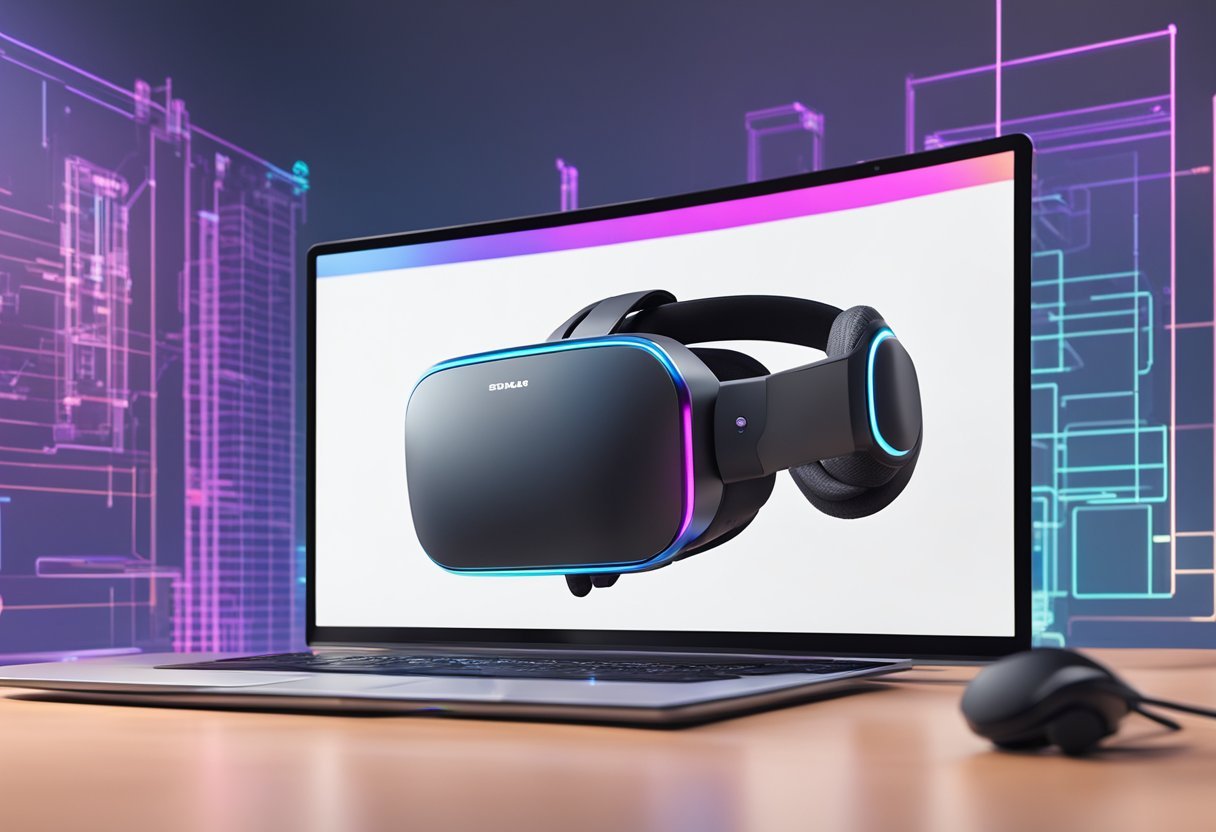The metaverse is an emerging virtual world that is becoming increasingly popular among tech enthusiasts. As the metaverse continues to grow in popularity, so does the demand for virtual reality (VR) headsets that can be used to explore this virtual world. However, the price of these headsets can be a major barrier to entry for many people.
The price of metaverse headsets varies depending on the brand, features, and specifications. For example, the Meta Quest 2 is an all-in-one VR headset that is priced at $249.00. It comes with 128GB of storage and is equipped with advanced features that make it a popular choice among gamers and tech enthusiasts. On the other hand, the Meta Quest Pro is a mixed-reality headset that is priced at $999.99. It is designed for professionals who want to use the metaverse for work or other purposes.
The price of metaverse headsets can be a significant investment for many people. However, the benefits of exploring the metaverse and experiencing virtual reality can be well worth the cost. As the technology continues to improve and become more accessible, it is likely that the price of these headsets will continue to decrease, making them more affordable for everyone.
Evolution of Metaverse Headsets
From VR to Mixed-Reality
The evolution of metaverse headsets has been a fascinating journey that started with the introduction of virtual reality (VR) headsets. VR headsets were designed to create a fully immersive experience by blocking out the real world and transporting the user to a virtual environment. This technology was a game-changer in the world of gaming, but it had its limitations.
The next step in the evolution of metaverse headsets was augmented reality (AR) technology. AR headsets allowed users to overlay digital content onto the real world, creating a mixed-reality experience. This technology was used in a variety of industries, including healthcare, education, and entertainment. However, the technology was still in its infancy, and the headsets were bulky and expensive.
Mixed-reality (MR) technology was the next step in the evolution of metaverse headsets. MR headsets combine the best of VR and AR technology, allowing users to interact with both virtual and real-world environments. This technology has the potential to revolutionize the way we work, learn, and play.
Key Technological Milestones
One of the key technological milestones in the evolution of metaverse headsets was the introduction of the Qualcomm Snapdragon XR2 platform. This platform was designed specifically for XR (extended reality) devices, including VR, AR, and MR headsets. The Snapdragon XR2 platform provided improved graphics, lower latency, and better battery life, making it possible to create more advanced and immersive metaverse headsets.
Meta (formerly Facebook) has been a major player in the development of metaverse headsets. The company’s Oculus Quest 2 headset was a game-changer in the world of VR, providing a wireless, all-in-one solution for virtual reality gaming. Meta has recently announced the release of the Quest Pro, which promises to take VR gaming to the next level with improved graphics and a wider field of view.
The Meta Quest Pro is not the only MR headset on the market. Microsoft’s HoloLens 2 is a mixed-reality headset designed for use in the workplace. The headset allows users to interact with digital content in a real-world environment, making it ideal for industries such as manufacturing and healthcare.
The evolution of metaverse headsets has been a fascinating journey, with each new technology building on the previous one. The future of metaverse headsets looks bright, with new advancements in technology promising to create even more immersive and interactive experiences for users.
Factors Influencing Metaverse Headset Price
The price of a Metaverse headset can vary depending on several factors. Here are seven key variables that influence the pricing of these devices:
1. Brand and Reputation
Established brands with a solid reputation in the tech industry tend to charge more for their products. This is because consumers are willing to pay a premium for quality and reliability. On the other hand, lesser-known brands may offer similar features at a lower price to attract customers.
2. Display Technology
The type of display technology used in a Metaverse headset can greatly impact its price. OLED and LCD displays are more expensive than traditional displays, but they offer higher resolution and better color accuracy. However, using cheaper display technology can help reduce the overall cost of the headset.
3. Processor and Graphics
The processing power and graphics capabilities of a Metaverse headset can also affect its price. More powerful processors and graphics cards are more expensive, but they can provide a better user experience with smoother graphics and faster load times.
4. Storage Capacity
The amount of storage capacity in a Metaverse headset can also impact its price. Headsets with larger storage capacity tend to be more expensive, but they allow users to store more games and apps on the device.
5. Accessories
Accessories such as controllers, sensors, and stands can also add to the overall cost of a Metaverse headset. Some headsets come with these accessories included, while others require users to purchase them separately.
6. Market Demand
Market demand can also influence the price of a Metaverse headset. If there is high demand for a particular headset, the manufacturer may increase the price to take advantage of the market. On the other hand, if there is low demand, the manufacturer may lower the price to attract more customers.
7. Production Costs
The cost of producing a Metaverse headset can also affect its price. If the production costs are high, the manufacturer may need to charge more to make a profit. However, if the production costs are low, the manufacturer may be able to offer the headset at a lower price.
Price Range of Popular Headsets
The price range of metaverse headsets varies widely, with entry-level, mid-range, and high-end options available to cater to different budgets and requirements. It is crucial to consider the overall value and experience offered by the headset to ensure a satisfying metaverse journey.
Here are some popular metaverse headsets and their price range:
- Meta Quest 3: The Meta Quest 3 is a popular VR headset that offers a great balance between affordability and quality. It is priced at around $399 on Meta’s site, making it highly affordable for most consumers.
- Oculus Quest 2: The Oculus Quest 2 is another popular headset that offers a great balance between affordability and quality. It is priced at around $399 on Meta’s site and comes in 128GB or 256GB memory capacities.
- HTC Vive XR Elite: The HTC Vive XR Elite is a high-end VR headset that offers an exceptional experience. It is priced at around $1,299 on Best Buy, making it a premium option for those who want the best experience possible.
- HP Reverb G2: The HP Reverb G2 is a high-end VR headset that offers an exceptional experience. It is priced at around $549 on HP’s site, making it a premium option for those who want the best experience possible.
The prices of these headsets vary widely, with the Meta Quest 3 being the most affordable and the HTC Vive XR Elite and HP Reverb G2 being the most expensive. The average price of a metaverse headset is around $800, with the minimum price being around $399 and the maximum price being around $1,299.
Top 15 Metaverse Headsets: Prices and Key Features
Below is a table of the top 15 Metavese headsets, their prices and key features:
| Headset | Price (USD) | Key Features |
|---|---|---|
| Meta Quest 2 | $299 | Affordable, wireless VR, facial tracking, large library of games and apps |
| Valve Index | $999 | High-resolution displays, finger tracking controllers, room-scale tracking, best-in-class VR for PC enthusiasts |
| HTC Vive Pro 2 | $1,399 | Ultra-high resolution displays, wide field of view, improved comfort, business-oriented features |
| PlayStation VR2 | $549 | Next-gen VR for PS5, haptic feedback controllers, eye tracking, improved resolution and field of view |
| Pimax Vision 5K Plus | $1,199 | Super-wide field of view (200°+), optional eye tracking and hand tracking, powerful specs for PC VR enthusiasts |
| Microsoft HoloLens 2 | $3,500 | Augmented reality headset for businesses and professionals, spatial mapping, hands-free interaction, enterprise applications |
| Magic Leap 2 | $2,295 | AR headset with focus on entertainment and productivity, light and comfortable design, advanced hand tracking and spatial computing |
| Lynx R-1 | $499 | Standalone VR headset with focus on fitness and productivity, lightweight design, self-contained processing, modular upgrades |
| Pico 4 Pro | $429 | Affordable standalone VR headset with high-resolution displays, pancake lenses, wireless connectivity, competes with Meta Quest 2 |
| Oculus Quest Pro (Rumored) | $499-$599 | Expected upgrade to Meta Quest 2, improved processing, higher resolution displays, advanced eye tracking, mixed reality features (rumored) |
| Varjo Aero | $2,899 | Professional VR headset with high-resolution bionic displays, human-eye level of detail, focus on professional applications and training |
| XTAL 3 | $3,499 | Standalone VR headset with focus on comfort and visual fidelity, modular design, high-resolution displays, eye tracking, optional hand tracking |
| HP Reverb G2 | $599 | High-resolution VR headset for PC enthusiasts, comfortable design, inside-out tracking, large sweet spot, competitive price |
| Vive Cosmos Elite | $549 | Modular VR headset from HTC, compatible with multiple faceplates and tracking systems, focus on customization and flexibility |
| StarVR One | $4,999 | High-end VR headset with ultra-high resolution displays, 210° field of view, professional applications and virtual arcades |
Meta’s Quest Series
Meta’s Quest series of headsets are some of the most advanced all-in-one VR systems available in the market. The series includes the Meta Quest 2, upcoming Quest 3, and Project Cambria.
Meta Quest 2
The Meta Quest 2 is a popular headset that offers an immersive virtual reality experience. This all-in-one VR system comes in two storage options, 128GB and 256GB, priced at $399.99 and $499.99, respectively. The headset has a high-resolution display and can be used for gaming, entertainment, and productivity purposes.
Recently, Meta announced a price increase of $100 for both storage options, which will come into effect from next month. Despite this, the Meta Quest 2 remains an affordable and accessible option for those looking to enter the world of VR.
Upcoming Quest 3 and Project Cambria
Meta’s Connect conference in 2021 saw the announcement of the upcoming Quest 3 and Project Cambria. The Quest 3 is set to be the most powerful headset yet, with a mass-market mixed reality experience and a starting price of $499.99 for the 128GB version and $649.99 for the 512GB version.
Project Cambria, on the other hand, is a research project aimed at developing a pair of AR glasses. These glasses will allow users to interact with the digital world while still being aware of the physical world around them. Meta CEO, Mark Zuckerberg, has stated that Project Cambria is still in its early stages and may take years to develop.
Meta’s Quest series of headsets offer a range of options for those looking to enter the world of VR. With the Meta Quest 2 already available and the Quest 3 and Project Cambria on the horizon, Meta is continuing to push the boundaries of what is possible in the world of virtual and augmented reality.
Technical Specifications and Features
Display and Optics
The Meta Quest Pro VR headset features pancake optics that offer a wider field of view and a more immersive experience. The lenses are adjustable, allowing users to fine-tune the focus to their personal preference. The headset also comes with a high-resolution display that delivers crisp and clear visuals.
The resolution of the display is 1832 x 1920 pixels per eye, which results in an overall resolution of 3664 x 1920 pixels. The pixel density is 700 pixels per inch, which ensures that the visuals are detailed and sharp.
Performance and Processors
The Meta Quest Pro VR headset is powered by the Qualcomm Snapdragon XR2+ chip, which is a powerful processor designed specifically for virtual and augmented reality. The chip delivers smooth and responsive performance, even when running demanding applications.
The headset also comes with 6GB of RAM, which ensures that there is enough memory to run multiple applications simultaneously. The Meta Quest Pro VR headset also features eye-tracking technology, which allows for more natural interactions and more immersive experiences.
The Meta Quest Pro VR headset is a premium mixed reality headset that offers advanced features and specifications. The headset features pancake optics, a high-resolution display, and a powerful processor, all of which combine to deliver an immersive and responsive experience. The eye-tracking technology further enhances the experience, allowing for more natural interactions.

Adoption and Market Trends
Consumer and Business Use Cases
The adoption of metaverse technology is expected to increase in the coming years, driven by the growing demand for immersive computing experiences. While gaming has been the primary use case for virtual reality (VR) headsets, businesses are also exploring the potential of metaverse technology for remote collaboration, training, and other applications.
According to Deloitte’s 2023 Digital Media Trends study, younger generations are more likely to use VR headsets regularly for at least one experience, indicating a growing interest in immersive computing. However, price remains a significant barrier to adoption, with lower-priced headsets being a key factor in the decision to enter the metaverse.
Meta’s recent price hike of $100 for its Quest VR headsets may further limit adoption among price-sensitive consumers. However, the company’s investment in the metaverse and its expansion of Horizon Workrooms for remote collaboration may drive adoption among businesses.
Future of Headset Technology
The market for metaverse headsets is expected to grow significantly in the coming years, with a projected CAGR of 41.83% from 2023 to 2028, according to a report by IDC. Apple’s recent entry into the market with its VR headset is expected to further drive growth and innovation in the industry.
The future of headset technology is likely to focus on improving the user experience through advancements in display technology, haptic feedback, and mobility. As the computing future becomes more immersive, developers are expected to create more sophisticated applications that take advantage of metaverse technology.
Investment in metaverse technology is also expected to increase, with large tech companies like Meta and Apple leading the way. As the market for metaverse technology grows, businesses and app developers are likely to explore new use cases and applications, driving further innovation in the industry.
Frequently Asked Questions
How much is the Meta VR headset?
The price range for the Meta VR headset varies depending on the model and features. Entry-level headsets typically start at around $200 and can go up to $400. Mid-range headsets range from $400 to $800, while high-end headsets can cost anywhere from $800 to over $1500.
Is Meta VR headset worth it?
The Meta VR headset is a great investment for anyone looking to experience the metaverse and immerse themselves in virtual worlds. The headset offers a high-quality experience with advanced features such as hand tracking and eye tracking. However, whether or not it is worth it depends on your personal preferences and budget.
Do you need a headset for the metaverse?
Yes, a headset is required to fully experience the metaverse. The headset allows you to immerse yourself in virtual worlds and interact with other users. There are several headsets available on the market, including the Meta VR headset, Oculus Quest, and PlayStation VR.
How much is the Meta AR VR headset?
The Meta AR VR headset is currently not available for purchase. The company has not yet announced a release date or price for the headset.
Does Meta VR require a subscription?
No, Meta VR does not require a subscription. Once you purchase the headset, you have access to the metaverse and all of its features.
Is Meta Quest 3 worth it?
The Meta Quest 3 is the latest version of the Meta VR headset. It offers advanced features such as hand tracking, eye tracking, and improved graphics. Whether or not it is worth it depends on your personal preferences and budget.
Is VR cheaper than AR?
The cost of VR and AR headsets varies depending on the model and features. Generally, VR headsets are less expensive than AR headsets.
Is Oculus and Meta the same?
Meta is the parent company of Oculus. Oculus is a subsidiary of Meta and produces VR headsets.
Do I need a computer for Meta Quest 2?
No, you do not need a computer for the Meta Quest 2. The headset is a standalone device and does not require a PC to operate.




